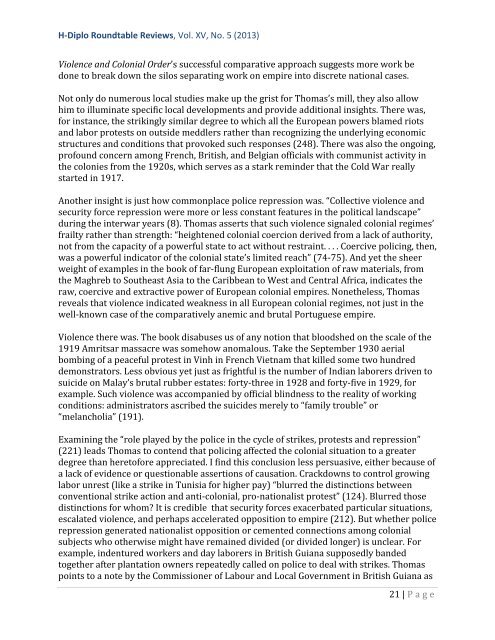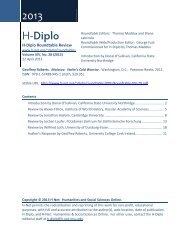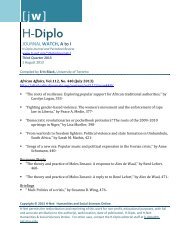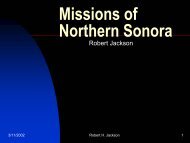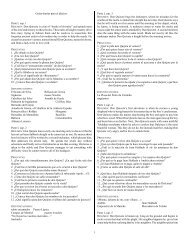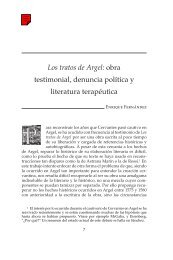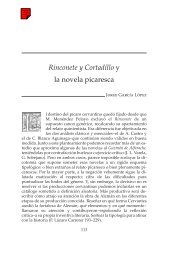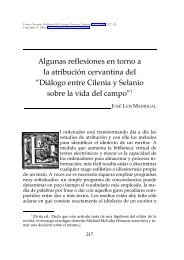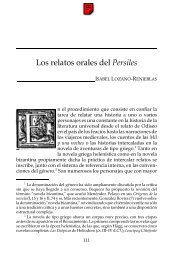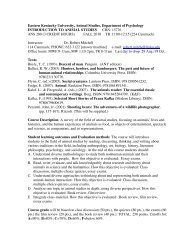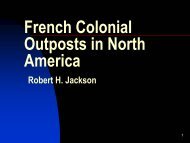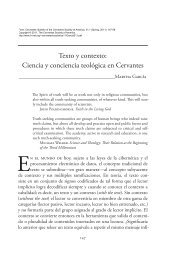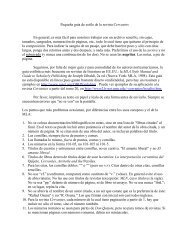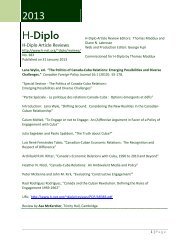H-Diplo Roundtable on Martin Thomas. Violence and ... - H-Net
H-Diplo Roundtable on Martin Thomas. Violence and ... - H-Net
H-Diplo Roundtable on Martin Thomas. Violence and ... - H-Net
Create successful ePaper yourself
Turn your PDF publications into a flip-book with our unique Google optimized e-Paper software.
H-<str<strong>on</strong>g>Diplo</str<strong>on</strong>g> <str<strong>on</strong>g>Roundtable</str<strong>on</strong>g> Reviews, Vol. XV, No. 5 (2013)<br />
<strong>Violence</strong> <strong>and</strong> Col<strong>on</strong>ial Order’s successful comparative approach suggests more work be<br />
d<strong>on</strong>e to break down the silos separating work <strong>on</strong> empire into discrete nati<strong>on</strong>al cases.<br />
Not <strong>on</strong>ly do numerous local studies make up the grist for <strong>Thomas</strong>’s mill, they also allow<br />
him to illuminate specific local developments <strong>and</strong> provide additi<strong>on</strong>al insights. There was,<br />
for instance, the strikingly similar degree to which all the European powers blamed riots<br />
<strong>and</strong> labor protests <strong>on</strong> outside meddlers rather than recognizing the underlying ec<strong>on</strong>omic<br />
structures <strong>and</strong> c<strong>on</strong>diti<strong>on</strong>s that provoked such resp<strong>on</strong>ses (248). There was also the <strong>on</strong>going,<br />
profound c<strong>on</strong>cern am<strong>on</strong>g French, British, <strong>and</strong> Belgian officials with communist activity in<br />
the col<strong>on</strong>ies from the 1920s, which serves as a stark reminder that the Cold War really<br />
started in 1917.<br />
Another insight is just how comm<strong>on</strong>place police repressi<strong>on</strong> was. “Collective violence <strong>and</strong><br />
security force repressi<strong>on</strong> were more or less c<strong>on</strong>stant features in the political l<strong>and</strong>scape”<br />
during the interwar years (8). <strong>Thomas</strong> asserts that such violence signaled col<strong>on</strong>ial regimes’<br />
frailty rather than strength: “heightened col<strong>on</strong>ial coerci<strong>on</strong> derived from a lack of authority,<br />
not from the capacity of a powerful state to act without restraint. . . . Coercive policing, then,<br />
was a powerful indicator of the col<strong>on</strong>ial state’s limited reach” (74-75). And yet the sheer<br />
weight of examples in the book of far-flung European exploitati<strong>on</strong> of raw materials, from<br />
the Maghreb to Southeast Asia to the Caribbean to West <strong>and</strong> Central Africa, indicates the<br />
raw, coercive <strong>and</strong> extractive power of European col<strong>on</strong>ial empires. N<strong>on</strong>etheless, <strong>Thomas</strong><br />
reveals that violence indicated weakness in all European col<strong>on</strong>ial regimes, not just in the<br />
well-known case of the comparatively anemic <strong>and</strong> brutal Portuguese empire.<br />
<strong>Violence</strong> there was. The book disabuses us of any noti<strong>on</strong> that bloodshed <strong>on</strong> the scale of the<br />
1919 Amritsar massacre was somehow anomalous. Take the September 1930 aerial<br />
bombing of a peaceful protest in Vinh in French Vietnam that killed some two hundred<br />
dem<strong>on</strong>strators. Less obvious yet just as frightful is the number of Indian laborers driven to<br />
suicide <strong>on</strong> Malay’s brutal rubber estates: forty-three in 1928 <strong>and</strong> forty-five in 1929, for<br />
example. Such violence was accompanied by official blindness to the reality of working<br />
c<strong>on</strong>diti<strong>on</strong>s: administrators ascribed the suicides merely to “family trouble” or<br />
“melancholia” (191).<br />
Examining the “role played by the police in the cycle of strikes, protests <strong>and</strong> repressi<strong>on</strong>”<br />
(221) leads <strong>Thomas</strong> to c<strong>on</strong>tend that policing affected the col<strong>on</strong>ial situati<strong>on</strong> to a greater<br />
degree than heretofore appreciated. I find this c<strong>on</strong>clusi<strong>on</strong> less persuasive, either because of<br />
a lack of evidence or questi<strong>on</strong>able asserti<strong>on</strong>s of causati<strong>on</strong>. Crackdowns to c<strong>on</strong>trol growing<br />
labor unrest (like a strike in Tunisia for higher pay) “blurred the distincti<strong>on</strong>s between<br />
c<strong>on</strong>venti<strong>on</strong>al strike acti<strong>on</strong> <strong>and</strong> anti-col<strong>on</strong>ial, pro-nati<strong>on</strong>alist protest” (124). Blurred those<br />
distincti<strong>on</strong>s for whom? It is credible that security forces exacerbated particular situati<strong>on</strong>s,<br />
escalated violence, <strong>and</strong> perhaps accelerated oppositi<strong>on</strong> to empire (212). But whether police<br />
repressi<strong>on</strong> generated nati<strong>on</strong>alist oppositi<strong>on</strong> or cemented c<strong>on</strong>necti<strong>on</strong>s am<strong>on</strong>g col<strong>on</strong>ial<br />
subjects who otherwise might have remained divided (or divided l<strong>on</strong>ger) is unclear. For<br />
example, indentured workers <strong>and</strong> day laborers in British Guiana supposedly b<strong>and</strong>ed<br />
together after plantati<strong>on</strong> owners repeatedly called <strong>on</strong> police to deal with strikes. <strong>Thomas</strong><br />
points to a note by the Commissi<strong>on</strong>er of Labour <strong>and</strong> Local Government in British Guiana as<br />
21 | P age


